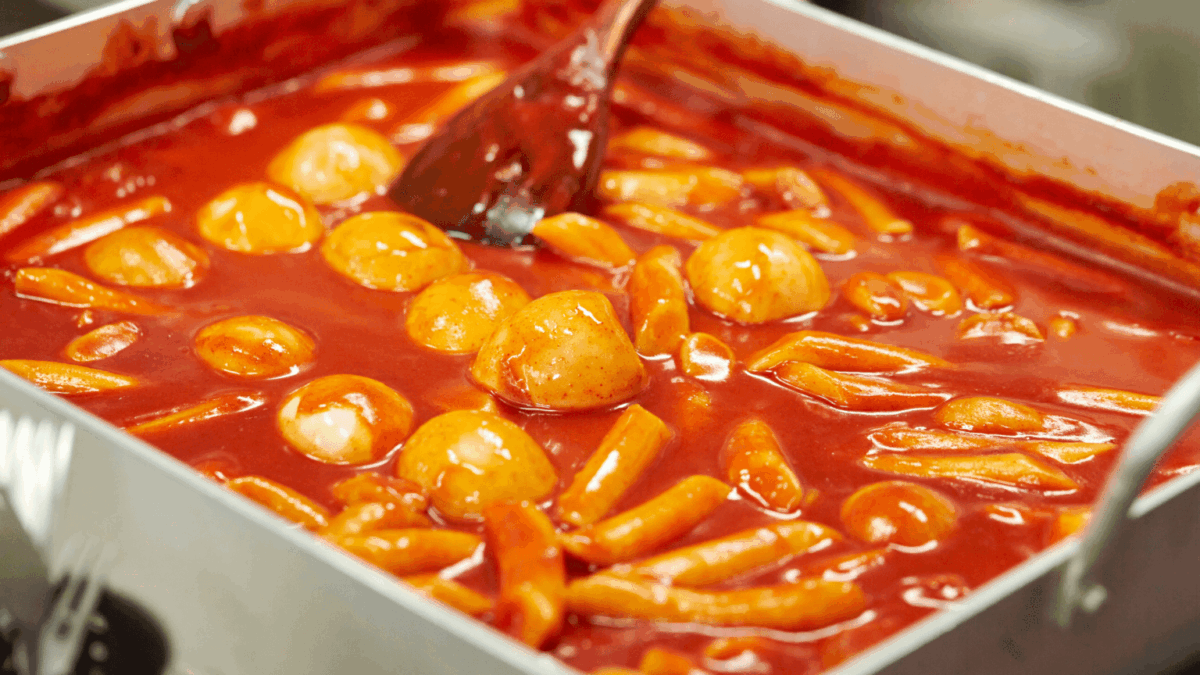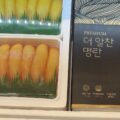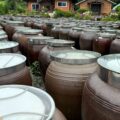Tteokbokki

If you’ve ever gone out for a drink in Korea, you’ve probably seen Tteokbokki on the menu. This spicy dish features chewy rice cakes simmered in a fiery red sauce and is a beloved snack among Koreans—whether enjoyed as Anju (drinking food), lunch, or dinner. It’s a must-try when visiting Korea! You can find many restaurants serving it, or can join the “Heart of Seoul” or “Seoul by Night” tours run by Korean Gourmet Hunters.
What is Tteokbokki?
Tteokbokki (떡볶이, pronounced “ddukbokki”) literally means stir-fried rice cakes. The chewy, cylindrical rice cakes (tteok or garaetteok) are usually stir-fried in a spicy sauce made with gochujang (Korean chili paste). Common ingredients include scallions, boiled eggs, and eomuk (fish cakes).
Originating in the 19th century, early Tteokbokki was made with soy sauce rather than the spicy chili paste used today. Now, spicy Tteokbokki is dominant, with popular variations including cheese to mellow the heat and Rabokki—Tteokbokki combined with ramyeon noodles, a student favorite.
Tteokbokki’s spicy sauce and chewy rice cakes make it the perfect Anju to enjoy with beer or soju. You’ll find it in bars and at street stalls called pojangmacha, where it’s served hot and fresh. Many restaurants now specialize in customizable Tteokbokki with a variety of toppings and sauces.
History
Tteokbokki’s origins trace back to the 19th century with soy sauce-based versions known as tteokjeongol (rice cake hot pot), tteokjjim (steamed rice cakes), and tteokjapchae (stir-fried rice cakes). These dishes included rice cakes, sirloin, sesame oil, scallions, pine nuts, and other ingredients and are still eaten today as Gungjung Tteokbokki (“royal court” style).
The spicy gochujang Tteokbokki emerged in the 1950s. Legend says Ma Bok Lim accidentally dropped rice cakes into spicy sauce at a Chinese restaurant opening and loved the taste, leading her to open a specialty restaurant in Sindang. This version became hugely popular nationwide.
After the Korean War, Tteokbokki was a working-class staple. Rice cakes were often made with wheat flour due to rice scarcity and cost. As the economy grew, rice flour became common again. With growing global influences, Tteokbokki has evolved to include cheese, rose sauce, black bean sauce, and more.
Ingredients
The traditional spicy Tteokbokki contains:
¤ Chewy, cylindrical Korean rice cakes (garaetteok)
¤ Fish cakes (eomuk), sliced thin
¤ Vegetables like onions, scallions, and cabbage
¤ Boiled eggs
¤ Spicy sauce made from gochujang (chili paste), soy sauce, sugar, garlic, and gochugaru (chili flakes)
¤ Popular toppings include cheese, ramyeon noodles, mandu (dumplings), ham, bacon, and others.
Types of Tteokbokki
There are countless variations! Some notable ones:
¤ Jeukseok Tteokbokki: A DIY style cooked at your table on a small stove, letting you customize spiciness and add extras like noodles or dumplings.
¤ Rabokki: Tteokbokki with ramyeon noodles, often topped with cheese.
¤ Cheese Tteokbokki: Traditional spicy Tteokbokki topped with melted mozzarella cheese to soften the heat.
¤ Rose Tteokbokki: Cream added to the spicy sauce, giving a mild, creamy kick; some places serve a creamy carbonara-like version without chili paste.
¤ Samyang Instant Tteokbokki: Instant versions available in convenience stores with flavors like creamy carbonara or ultra-spicy Buldak.
¤ Jajang Tteokbokki: Made with sweet black bean paste sauce (jajang), similar to Jajangmyeon.
¤ Fried Tteokbokki: Deep-fried rice cakes without sauce, also called gireum tteokbokki.
Best Tteokbokki in Seoul
Looking for the best Tteokbokki in Seoul? Here are popular spots:
¤ Yeopgi Tteokbokki: Famous for extremely spicy Tteokbokki, with 5 spice levels and many toppings; founded in 2002 in Dongdaemun.
¤ Hongdae Jopok Tteokbokki: A 20+ year-old restaurant in Hongdae’s nightlife district, rumored to have started as a food truck by a Korean gangster.
¤ Mabongnim Tteokbokki: Founded by Ma Bok Lim herself in Sindangdong’s Tteokbokki town, open since 1945 with 70+ years of history.
¤ Night Markets: Places like Dongdaemun, Myeongdong, and Seoul Bam Dokkaebi Night Market offer tasty Tteokbokki street food. Tongin Market is famous for fried Tteokbokki.
¤ Ichondong Smile Tteokbokki: Near Ichon station, serving “soup-style” Tteokbokki (gukmul tteokbokki) since 1980.
Frequently Asked Questions
¤ What does Tteokbokki taste like?
Spicy, slightly sweet, and hearty, with a chewy texture. Cheese or cream variations mellow the heat. Non-spicy soy sauce or royal court styles offer milder flavors.
¤ What’s the difference between rice and wheat flour rice cakes?
Wheat flour rice cakes are less chewy than those made with rice flour.



